 Image search results - "maritime" Image search results - "maritime" |
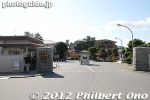
Entrance to the Naval Academy on Etajima.
|
|
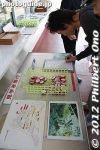
Reservations are not required, but you have to get there and sign up 5 min. before the 90-min. tour starts.
|
|

The Naval Academy conducts free guided tours of the school 3 or 4 times a day. The tour takes you around the campus and allows you to enter a few of the imposing buildings.
|
|

Map of the Naval Academy or Japanese Maritime Self Defense Force First Service School (海上自衛隊第1術科学校).
|
|
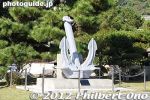
You cannot tour the Naval Academy on your own. You have to join the guided tour. There is a dress code: No miniskirts or provocative clothing by women.
|
|
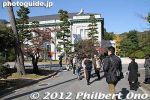
Two Naval Academy students served as our tour guide.
|
|
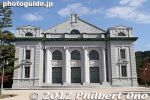
Ceremonial Hall. Built in 1917 and designed for holding ceremonies and moral education. One of the few buildings which we could enter. Etajima, Hiroshima.
|
|
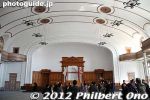
Inside the Ceremonial Hall. It can fit 2,000 people.
|
|
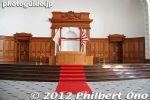
Stage inside the Ceremonial Hall.
|
|
|
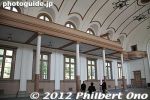
Ceremonial Hall
|
|
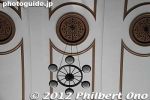
The lights look like a ship's wheel on the ceiling of the Ceremonial Hall.
|
|
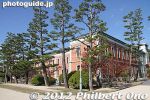
The academy's pine tree trunks grow straight up. They say that even the pine trees stand at attention at the school.
|
|
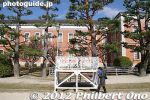
Stand for gatherings.
|
|
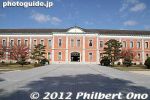
The academy's most distinctive building is this Students’ Hall dubbed the "Red Brick Building." We weren't allowed to go inside. Etajima, Hiroshima.
|
|
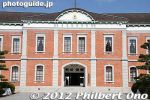
Built in 1893 and used for classrooms and living quarters for students. Today, it is part of the Officer Candidate School and used as classrooms and students' living quarters. Etajima, Hiroshima.
|
|
|
|
|
|
|
|
|
|
|
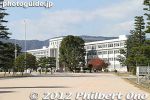
Students' Hall west wing. Built in 1938, it is used as the main students’ hall of the First Service School.
|
|

Students' Hall west wing. We weren't allowed to enter this building. The Academy also has female students, but after graduating they do not serve on navy ships. They work only on land.
|
|
|
|
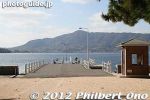
Front Pier. This is considered the school's front gate instead of the gate on land. Officer Candidate School graduates are sent off here by school staff and a military band and transferred to a training fleet anchored offshore in Etauchi inlet.
|
|
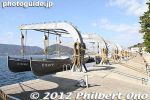
Training boats
|
|
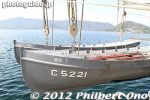
Training boats
|
|
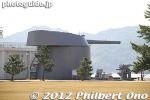
Battleship gun, life-size.
|
|
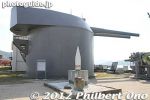
The Gun turret was a part of the main gunnery system of Battleship Mutsu and was transferred to Imperial Naval Academy for use as a study aide in 1935.
|
|
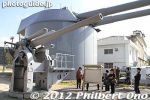
Gun turrets
|
|
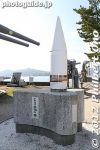
Projectile of a "Mutsu" class battleship.
|
|
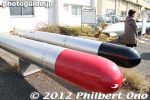
Torpedoes
|
|
|

Naval History Museum on Etajima. Built in 1936, the museum is substantial with detailed exhibits tracing Japan's naval history (including the Pearl Harbor attack).
|
|
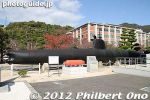
The Naval History Museum on Etajima has this outdoor display of one of the five midget submarines used in the Pearl Harbor attack.
|
|
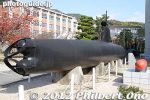
One of the five midget submarines used in the Pearl Harbor attack. On display at the Naval History Museum on Etajima island, Hiroshima.
|
|
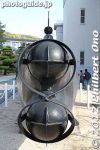
Torpedo bay of midget submarine used in Pearl Harbor attack.
|
|
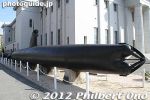
The midget sub displayed here was found in 1960 off Keehi Lagoon east of Pearl Harbor's entrance. The sub had been damaged by a depth charge attack and abandoned by its crew before it could fire its torpedoes.
|
|
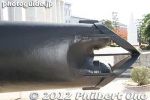
It was subsequently salvaged and restored for display at Etajima in 1962. The front part of the sub was severed, so the front part was reconstructed by a Kure shipbuilder for this display.
|
|
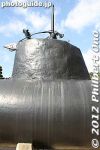
Midget sub's conning tower and periscope. The sub had only two crew members.
|
|
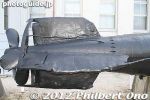
Midget sub's rudder and propeller.
|
|
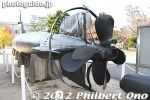
They eventually found all five subs (the fifth one was finally found in 2009) used at Pearl Harbor. Two of them are on display. One of them is here and the other is at the National Museum of the Pacific War in Fredericksburg, Texas.
|
|
|
|
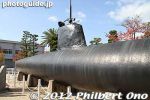
This midget sub was transported by boat from Pearl Harbor to Yokosuka (Kanagawa Pref.), then to Etajima in 1961.
|
|
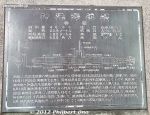
About this midget sub: Length: 23.9 meters, Weight: 46 tons, Inner diameter: 1.85 meter, Underwater speed: 19 knots (600 horsepower)
|
|
|
|
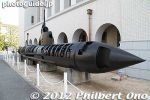
Behind the midget sub used in Pearl Harbor, another different type of midget sub is displayed.
|
|
|
|
|
|
|
|
|
|
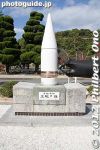
A projectile used by battleship Yamato during WWⅡ.
|
|
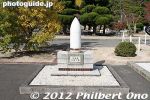
Projectile used in Japan-China War in 1894.
|
|
|
|
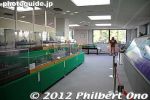
Last stop on the tour was the Etajima Club where there is a gift shop, restaurant, and this small museum on the 2nd floor.
|
|
|
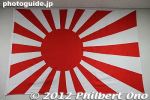
Japanese navy rising sun flag
|
|
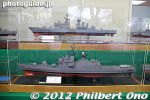
Models of navy warships.
|
|
|
|
|
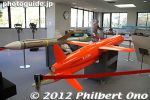
Etajima Club exhibition room.
|
|
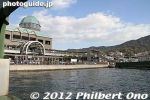
Kure Port in Hiroshima Prefecture. We arrived from Etajima island across the Seto Inland Sea. Kure is also a short train ride from Hiroshima Station.
|
|
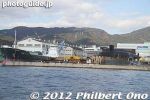
From the boat, we could see the dock where the Battleship Yamato was built in Kure, Hiroshima. "Kure" is pronounced "Kuray" not like the word "cure."
|
|
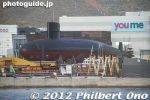
We could also see the submarine museum at the JMSDF Kure Museum adjacent to the Yamato Museum.
|
|
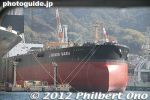
Kure is a major shipbuilding town.
|
|
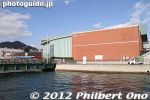
Back of the Yamato Museum facing Kure Port.
|
|
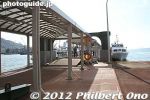
Kure Port dock.
|
|

Entering Kure Port terminal.
|
|

Welcome to Kure.
|
|
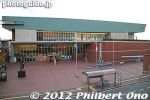
Yamato Museum's official name is Kure Maritime Museum. Although the 1/10 scale model of Battleship Yamato is the main attraction, it also has other exhibits explaining Kure's maritime history.
|
|

The Yamato Museum is open 9 am to 6 pm (enter by 5:30 pm). Admission is 500 yen for adults, 300 yen for high schoolers, and 200 yen for kids. Battleship Yamato was built in Kure.
|
|
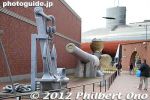
Outside the museum, a battleship gun and anchor are displayed.
|
|
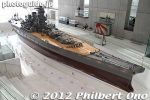
Yamato Museum's main attraction is this large scale model of Battleship Yamato. You can walk around it. This area of the museum is called Yamato Hiroba.
|
|
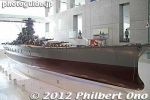
The scale model of the battleship is 26.3 meters long. It has been reconstructed as accurately as possible based on photographs and exploration of the wreck.
|
|
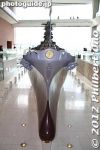
Battleship Yamato has an Imperial chrysanthemum crest on the bow. This was one of the things which helped to identify the wreck on the sea bottom.
|
|
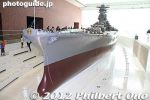
Battleship Yamato was commissioned a week after the Pearl Harbor attack in Dec. 1941. It was Japan's most powerful battleship and now legendary. It turned out to be great waste since the big guns were hardly used and it was sunk 4 years later.
|
|

"Yamato" is another name for Japan, and so it is a very revered and prestigious name for any ship. Many movies, anime, etc., have been based on Battleship Yamato which retains a strong cultural influence in Japan.
|
|
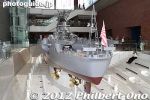
The Yamato's final mission was suicidal. It was ordered to go to Okinawa in April 1945 and beach herself offshore so it wouldn't sink. While beached, it would fire its guns at the enemy on Okinawa.
|
|
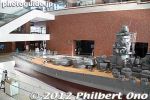
On her way to Okinawa, the Yamato was spotted by US submarines and aircraft and sunk by American carrier-based bombers and torpedo bombers on April 7, 1945.
|
|
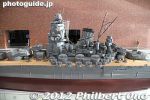
Since the Yamato was built in secrecy, there are very few clear photos of the ship.
|
|
|
|
|
|
|
|
|
|
|
|
|
|
|
|
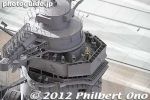
The model even has little human figures.
|
|
|
|
|
|
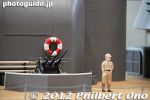
All aboard!
|
|
|
|
|
|
|
|
|
|
|
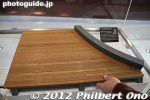
Sample wood paneling used for the model deck.
|
|
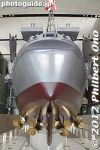
Propellers of Battleship Yamato.
|
|
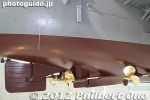
Rudder and propellers of Battleship Yamato.
|
|
|
|
|
|
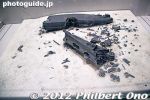
One exhibition room has a model of the Battleship Yamato wreck.
|
|

Admiral Isoroku Yamamoto's connection with Kure. On the bridge of the Yamato, he commanded the fleet at the Battle of Midway.
|
|
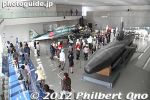
Another large exhibition room had a Japanese Zero fighter plane, kaiten manned torpedo, and midget submarine.
|
|
|
|
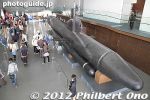
Midget submarine.
|
|
|
|
|
|
|
|
|
|
|
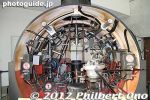
Midget submarine cockpit.
|
|
|
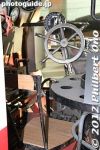
Midget submarine cockpit.
|
|

About midget submarines.
|
|
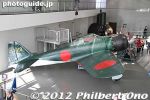
Japanese Zero fighter.
|
|
|
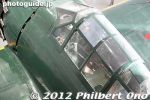
Japanese Zero fighter cockpit.
|
|
|
|
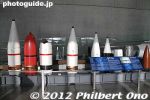
Gun shells
|
|
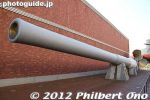
41-cm diameter gun from Battleship Mutsu, outside the Yamato Museum. Until the Yamato was built, the Mutsu was Japan's largest battleship.
|
|

Battleship Mutsu plaque. After seeing the Yamato Museum, be sure to cross the street over to the submarine museum called the JMSDF (Japan Maritime Self-Defense Force) Kure Museum.
|
|
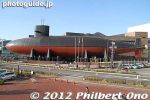
The JMSDF (Japan Maritime Self-Defense Force) Kure Museum is mainly a submarine museum whose main attraction is the decommissioned Japanese sub called Akishio. The museum is conveniently right across the street from the Yamato Museum.
|
|
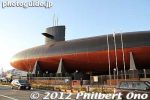
The former Akishio submarine just stands out and can be seen from boats approaching Kure Port. Very impressive to be seen on land amid small cars passing by. The museum is a short walk from JR Kure Station.
|
|
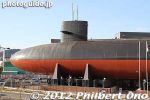
The museum has one normal building and this decommissioned submarine accessible from the main museum building. The submarine is largely intact on the inside.
|
|
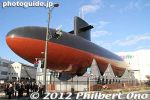
The Akishio submarine was commissioned in March 1986 and decommissioned in March 2004. It was brought here in 2006. The sub is 76.2 meters long. Top speed was 20 knots underwater.
|
|
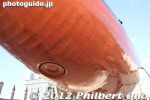
The JMSDF Kure Museum is JMSDF's submarine and minesweeping museum. It also has a surface ship museum in Sasebo, Nagasaki and an aircraft museum in Kanoya, Kagoshima.
|
|
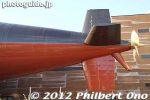
JMSDF Kure Museum is open 9 am to 5 pm (enter by 4:30 pm). Closed Tue. (open if a national holiday and closed on the Wed. instead). Free admission. Rudder and propeller of the Akishio submarine.
|
|
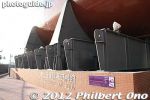
Looks sturdy enough so the sub won't roll away in a large earthquake.
|
|
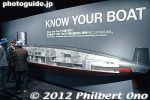
The museum's main building has exhibits explaining about Japanese submarines.
|
|
|
|
|
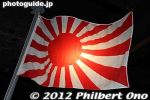
Flag of the Japanese navy.
|
|

Japanese submarine classes.
|
|

Model of the SS Kuroshio sub.
|
|
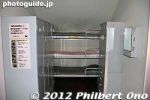
Replica of submarine sleeping quarters.
|
|
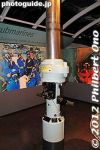
Periscope replica.
|
|
|
|
|
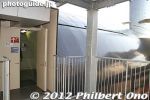
From the main building, we can cross over to the Akishio submarine.
|
|
|
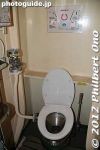
Toilet on the Akishio submarine.
|
|
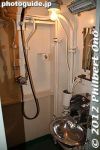
Shower and toilet sink on the Akishio.
|
|
|
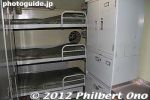
Sleeping quarters on the Akishio submarine.
|
|
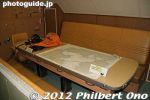
Conference room.
|
|
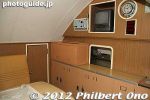
Conference room.
|
|
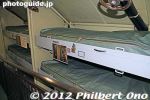
Bunk beds are short and narrow. Two men share one bunk bed as they sleep in turns.
|
|
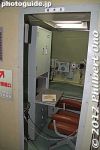
Captain's quarters. Still pretty cramped.
|
|
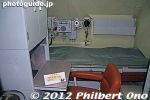
Captain's quarters. Outfitted with some communications gear at his bedside.
|
|
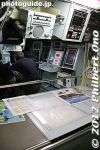
The bridge.
|
|
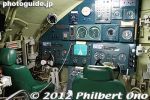
Pilot seats.
|
|
|
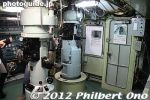
Two periscopes.
|
|
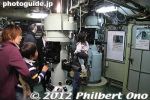
We could look through the periscopes.
|
|
|
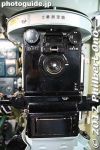
Periscopes made by Nikon?
|
|
|
|
|
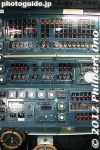
Looks very complicated.
|
|
|
|
|
|